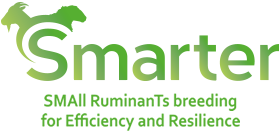
This project has received funding from the European Union’s Horizon 2020 research and innovation programme under grant agreement No 772787.
Objectives
SMARTER will use new and collaborative strategies to improve resilience and efficiency (R&E) of the sheep and goat sectors at the animal (A), population/breed (P) and system/farm (S) levels. The overall goal of SMARTER is i) to phenotypically and genetically characterise and understand novel R&E related traits, ii) to improve and develop new genomic prediction techniques, and iii) to establish new breeding and management strategies that include those novel R&E related traits according to their importance and relevance to various systems, breeds and environments. The project will promote optimised resilience of small ruminant farming systems, which are key pillars of socio-economic sustainability and eco-system services in rural communities throughout Europe and beyond.
At the fundamental level, the project will:

- Identify and characterise phenotypic novel measures using low cost automated devices, new recording schemes, and integrative modelling for R&E related traits in controlled and extensive environments. R&E traits will include feed efficiency, body reserve mobilisation, health and welfare, lamb vigour/survival, and the ability to recover from environmental and disease challenges;
- Quantify the genetic variability of R&E related traits in common breeds and in hardy and under-utilised breeds well-adapted to their local harsh environments and identify genomic DNA (DeoxyriboNucleic Acid variants) and non-genomic variability (epigenetic, metagenomics and transcriptomic;
- Characterise genetic synergies and trade-offs among R&E and other production traits;
- Quantify the extent and relevance of genotype-by-environment interactions (G*E) for R&E related traits between conventional and organic farms and between various feeding and climatic;
- Enhance the benefit of genomic selection in small ruminants by tailoring and improving models that include multi-population/breed and G*E.
At the technological and applied level, the project will:
- Propose and validate new, low-cost predictors of R&E related traits in ruminants for widespread phenotyping at the population level
Deliver genetic and genomic breeding values for novel R&E related traits; - Develop decision support tools to be used by scientists, farmers and animal breeders for managing trade-offs and optimising R&E of animals under a variety of challenging conditions;
- Develop tools to boost networking among breeders and breeder associations of hardy and under-utilised breeds in order to enhance and market the value of their unique characteristics;
- Develop tools to maximise heterozygosity, promote expression of heterosis, and manage genetic diversity;
- Develop new methods to increase genomic selection efficacy in small ruminants by including the use of pure and crossbreed populations and major gene information;
- Deliver recommendations for strategic use of new genomic tools including a comparison of efficacy and cost of using genomic tools with different SNP (Single Nucleotide Polymorphism) densities;
- Perform the first across-country genomic evaluations in small ruminants by pooling phenotypic and genomic data and creating new shared reference populations in sheep (UK, France, Spain, Ireland, Uruguay) and goats (France, Italy, Canada);
- Develop protocols and assess benefits of across-country evaluation;
- Provide international guidelines for harmonious measurement, reporting and analysis of R&E related traits on farm;
- Create an international initiative that will facilitate, encourage and motivate the exchange of information, know-how and data (phenotype, genotype and pedigree) for international cooperation and improved breeding for R&E in small ruminants;
- Propose new and optimised breeding strategies that utilise R&E related traits and trade-offs and balance economic, social and environmental challenges;
- Evaluate the social acceptance, and the economic, social and environmental benefit of breeding strategies that utilise R&E related traits coupled with advanced genomic tools toward balanced breeding goals;
- Foster interactions between partners and external scientific community members and stakeholders during multi-actor round tables and training activities;
- Enhance capacity building of small ruminants stakeholders and scientists.

